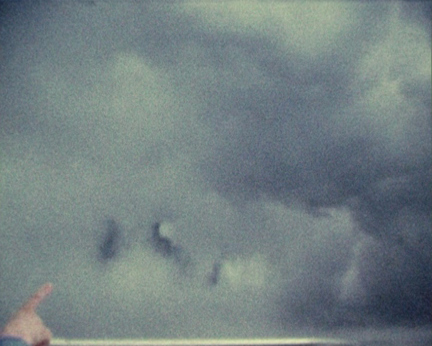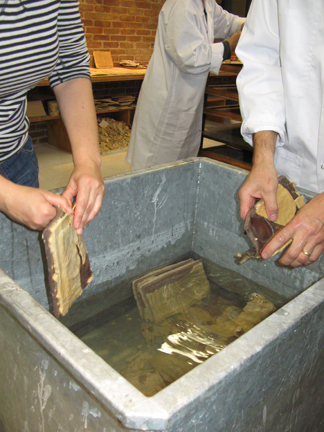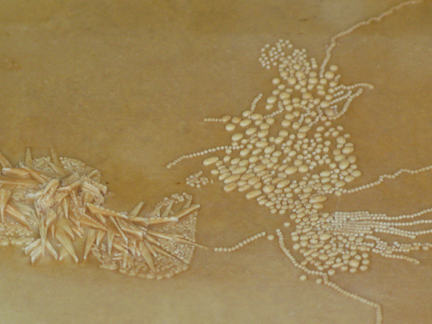PHYSICAL GEOLOGY

THE CAVE ETCHING EXPERIMENT
GEOLOGIC INTIMACY/PHYSICAL GEOLOGY
Please explain this impulse to me –
attempting physical contact with geological time.


The human consciousness may have begun to leap and boil some sunny day in the Pleistocene, but the race by and large has retained the essence of its animal sense of time. People think in five generations – two ahead, two behind – with heavy emphasis on the one in the middle. Possibly that is tragic, and possibly there is no choice. The human mind may not have evolved enough to be able to comprehend deep time. It may only be able to measure it. At least, that is what geologists wonder sometimes, as they have imparted the questions to me. They wonder to what extent they truly sense the passage of millions of years. They wonder to what extent it is possible to absorb a set of facts and move beyond them, in a sensory manner, beyond the recording intellect and into the abyssal eons. Primordial inhibition may stand in the way. On a geologic time scale, a human lifetime is reduced to a brevity that is too inhibiting to think about.1
Recently, I have been spending time in the ‘oddities’ drawer of the geology department at the Manchester Museum. In it, I came upon a very fine collection from Mount Vesuvius of lava medallions - magma pressed between forged steel plates to form an imprint. Imagine a waffle iron that makes use of lava instead of pancake batter. In the same drawer, a small stone relief sculpture which appeared to be carved out of pure white alabaster was in fact revealed to be a limestone cast made through the same process which forms stalactites in a cave – the residue of a high velocity calcifying process.



I have been thinking about physical geological time – the fast moving lava flow vs. slow time inside a cave. The impulse to understand geothermal water through boiling milk in a 100 degree Celsius sulphur spring in the crater of an active volcano. I spoke with a paleontologist who told me a fossil is the presentation of the moment of death, that trace fossils record an action - eating or walking, but not the organism itself.

Jim said to me, a volcano buries itself. It perpetually erases its own history. A volcanologist explained the nature of love to me. He said, you love what you get to know, what you pay attention to and therefore become more aware of. This is not a passive form of love.
This is how I feel about the volcano.
I went to Saint Nectaire, a small thermal town in the mountains of the Auvergne in France. I met with Eric Papon, whose family founded the Fontaines Petrifiantes seven generations ago. His ancestor was exploring the limestone caves of the area, when he came upon a perfect cast of a leaf – even the tiny veins of this small leaf were etched in stone. He realized the carbonate waters could be harnessed and used to a different effect, and the art of cave casting was born. In a normal limestone cave it takes 100 years for a stalactite to grow 1 centimeter, in these caves 1 centimeter grows in 1 year.
Today, there are twenty-four meter high ladders installed in the caves. Natural rubber plates with relief impressions on one side are placed on the rungs of the ladder. Every day Eric and his assistant turn every object – hundreds of them - so they do not become part of the cave. Carbonate waterfalls cascade over the plates. At the end of one year they are entirely encrusted in limestone. When the casts are ready to come out, like an ice cube in the freezer that is no longer part water, the experiment is done. One side a rough stalactite, one side a delicate orchestrated ornate intrusion.
NOTES ON PHYSICAL GEOLOGY

The lava medallion is an imprint of a specific action – in this way it is akin to a photograph. Marking one instant in time. The lava medallion as a grave marker/ a marker for an event in time. The lava medallion as a snapshot – a photograph taken in one moment as opposed to the long exposure, which we could say is more akin to the pin-hole photography (geology) evident in the caves of Saint Nectaire – the gradual accumulation.
The cave cast can also be likened to a drawing, a record of incremental change. A cave cast is a miniscule representation of geological time – durational time – in that 1.5 years is nothing in a geological time context, but within a daily context it is quite long – a lot can happen in a year and a half. Within an arts context, a year and a half is also quite a long duration. A continually occurring process forming a piece of work.
The cave cast serves as a ‘stand in’ for geological time. Recently someone asked if I would be interested in exploring natural phenomena like slow erosion, or how mountains move – really deep time processes that we as humans will not see the results of within our lifetime, but nonetheless continue to take place on an ongoing basis.

My response is, though of course I am interested in such processes, a key aspect of what I do is finding approximations in real life that make sense of things that are, in effect, incomprehensible. What does 300,000,000 years mean, just like what does 30,000 dead mean? I can’t understand the temperature of underground magma; I can however make contact with its cousin – a geothermal pool in which to boil milk.
I should mention one other aspect about the caves of Saint Nectaire, there are two carbonate activities that take place in these mountains.
Encrustation and casting.
You have heard detail about the casting process. For encrustation, the following occurs. An animal dies. It is stuffed. It is placed underneath the waterfalls, turned every day like the other objects, and at the end of a year, maybe two, the animal is entirely encrusted in limestone. You could say it is petrified, but it is not. If it were petrified it would turn to stone – from a living thing to geology complete. In the case of Saint Nectaire, the animals are encased, surrounded by a stalactite.
But at what moment does wood become stone, peat become coal, limestone become marble? 2

The plan is to make a geological time diptych – new lava medallions, new cave casts –
slow time and fast time alongside each other.
END NOTES
1. From Getting the Picture by John McPhee
2. From Fugitve Pieces by Anne Michaels
IMAGES
Volcanic images, stills from new Super 8 film shot on location in Big Island, Hawaii at the lava entry ocean point in April 2009.
Cave cast images, taken in the cave workshop in the Fontaines Petrifiantes in September 2009, as we 'demould' our newly formed cast stalactites.
THANKS TO
Alchemy at The Manchester Museum, The University of Manchester, Arts Council of England, Fraser Bruce, ISO, Fontaines Petrifiantes, Andrew Patrizio, doggerfisher, Dundee Contemporary Arts, Scottish Arts Council, British Council Darwin Now Awards, Talbot Rice Gallery, Don Swanson at Hawaiian Volcano Observatory, Ken Hon at University of Hawaii at Hilo and D.A.H.
![]()